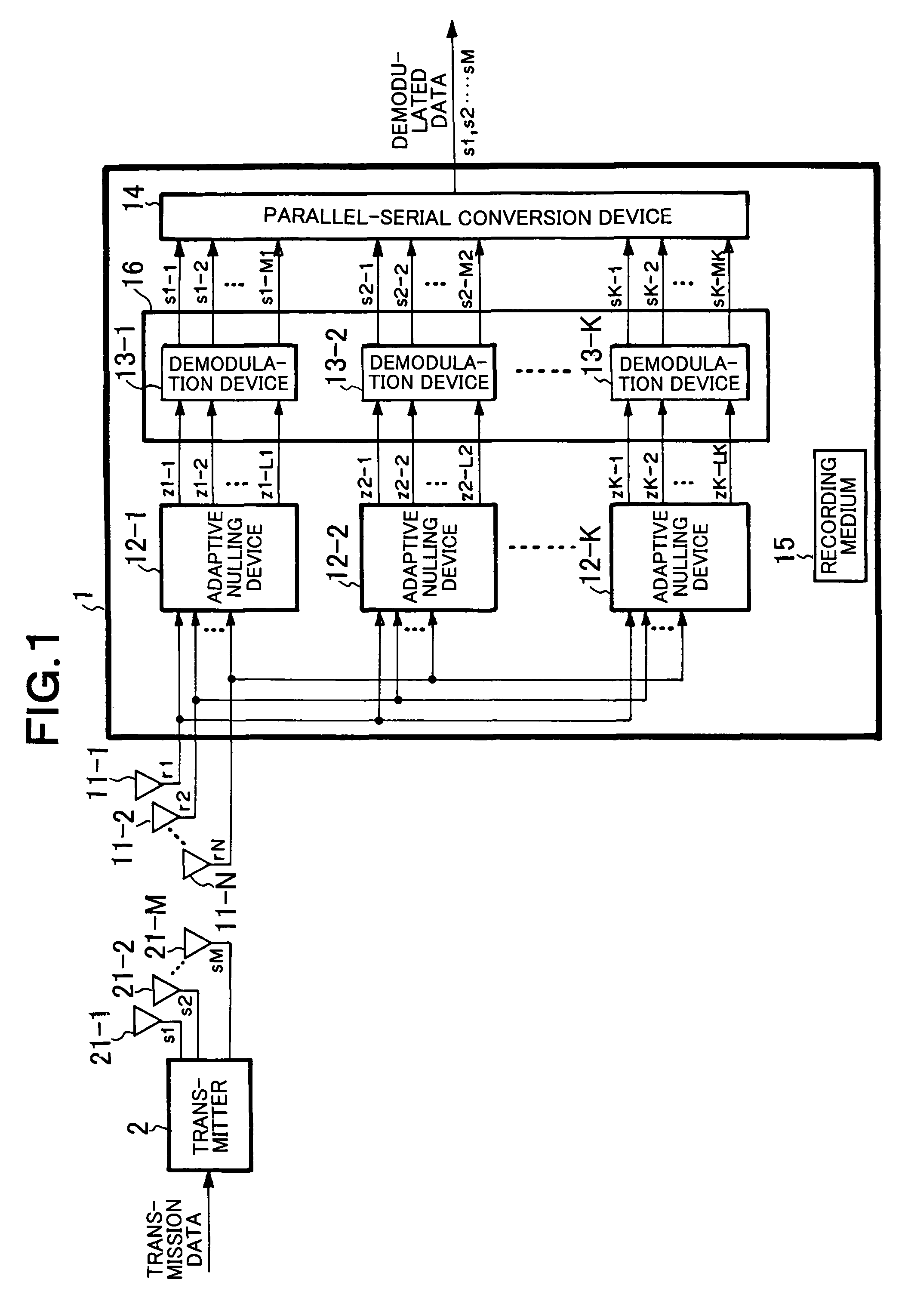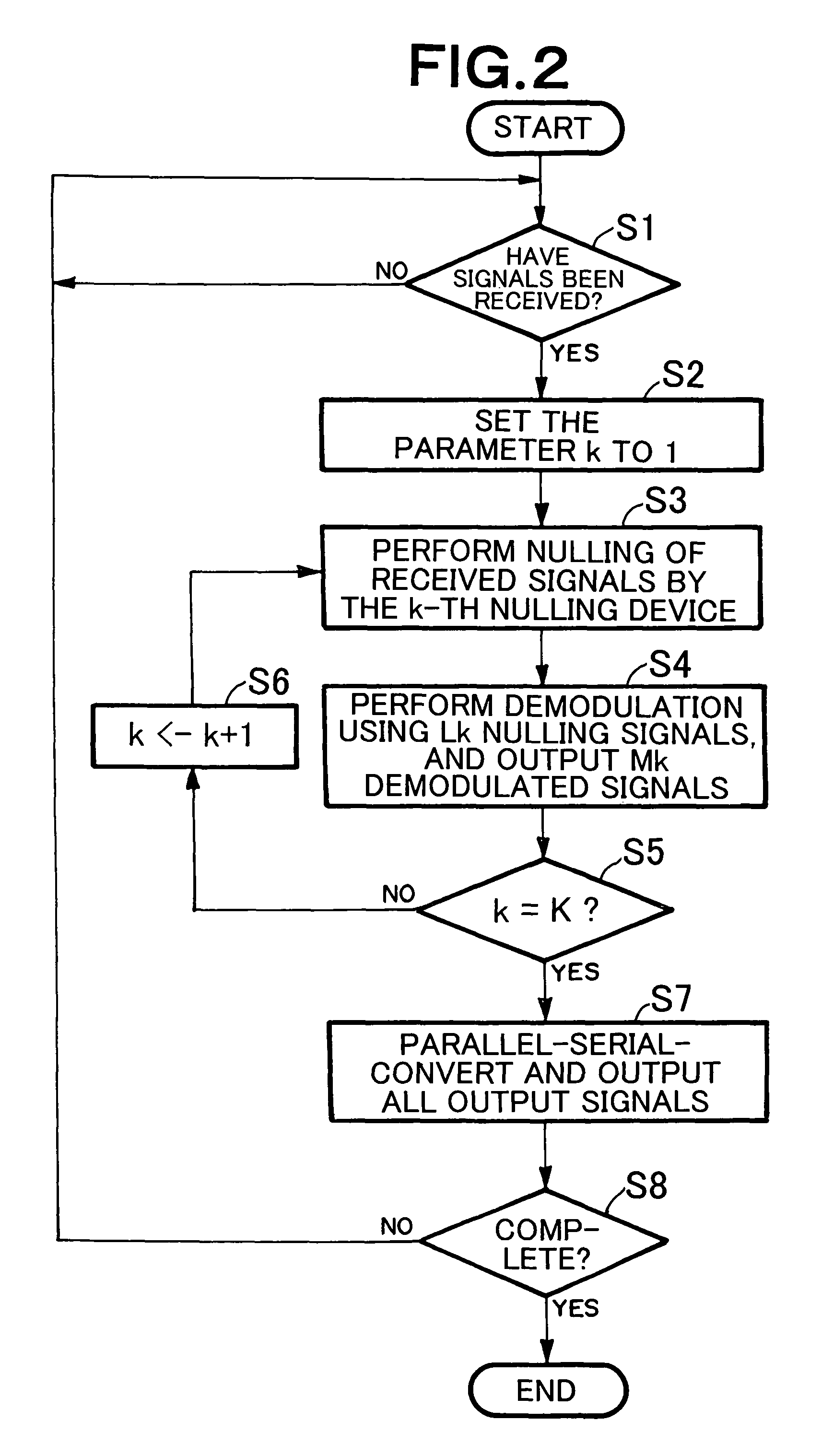Wireless communication system, receiver, demodulation method used for the system and receiver, and program thereof
a communication system and receiver technology, applied in the field of wireless communication systems, can solve problems such as difficulty in the receiver b>12, estimation nb, and problems in the related art as described abov
- Summary
- Abstract
- Description
- Claims
- Application Information
AI Technical Summary
Benefits of technology
Problems solved by technology
Method used
Image
Examples
first embodiment
[0060]FIG. 1 is a block diagram showing the structure of the first embodiment of the present invention.
[0061]Referring to FIG. 1, the wireless communication system according to the present embodiment has a structure including a transmitter 2 and a receiver 1. The transmitter 2 generates transmission signals s1 to sM (M is an integer not smaller than 2) from transmission data and transmits the transmission signals s1 to sM through M transmission antennae 21-1 to 21-M. The receiver 1 receives the signals from the transmitter 2 through N reception antennae 11-1 to 11-N (N is an integer not smaller than 2) and demodulates and outputs the received signals r1 to rN.
[0062]The receiver 1 has K adaptive nulling devices 12-1 to 12-K (K is an integer not smaller than 2 and not greater than M), an adaptive demodulation device 16, a parallel-serial conversion device 14, and a recording medium 15. The adaptive nulling devices 12-1 to 12-K are connected to the output sides of the N reception anten...
second embodiment
[0072]Next, the second embodiment of the present invention will be described in details with reference to the drawings.
[0073]FIG. 3 is a block diagram showing the structure of the present embodiment. The wireless communication system according to the present embodiment has the same structure as the first embodiment shown in FIG. 1 except that another receiver 3 is provided in place of the receiver 1.
[0074]Referring to FIG. 3, the receiver 3 according to the present embodiment receives transmission signals s1 to sM based on transmission data, which are transmitted through M transmission antennae 21-1 to 21-M from the transmitter 2, through N reception antennae 11-1 to 11-N. The receiver 3 demodulates and outputs the received signals r1 to rN. This receiver 3 has K adaptive nulling devices 12-1 to 12-K (K is an integer not smaller than 2 and not greater than M), an adaptive demodulation device 33, a parallel-serial conversion device 14, and a recording medium 32. The adaptive nulling ...
third embodiment
[0081]Next, the third embodiment of the present invention will be described in details with reference to the drawings.
[0082]FIG. 5 is a block diagram showing the structure of the present embodiment. The wireless communication system according to the present embodiment has the same structure as the first embodiment shown in FIG. 1 except that another receiver 4 is provided in place of the receiver 1.
[0083]Referring to FIG. 5, the receiver 4 according to the present embodiment receives transmission signals s1 to sM transmitted through M transmission antennae 21-1 to 21-M from the transmitter 2, through N reception antennae 11-1 to 11-N. The receiver 4 demodulates and outputs the received signals r1 to rN. This receiver 4 has K adaptive nulling devices 12-1 to 12-K, an adaptive demodulation device 45, a parallel-serial conversion device 14, and a recording medium 46. The adaptive nulling devices 12-1 to 12-K are connected to the output sides of the N reception antennae 11-1 to 11-N. Th...
PUM
 Login to View More
Login to View More Abstract
Description
Claims
Application Information
 Login to View More
Login to View More - R&D
- Intellectual Property
- Life Sciences
- Materials
- Tech Scout
- Unparalleled Data Quality
- Higher Quality Content
- 60% Fewer Hallucinations
Browse by: Latest US Patents, China's latest patents, Technical Efficacy Thesaurus, Application Domain, Technology Topic, Popular Technical Reports.
© 2025 PatSnap. All rights reserved.Legal|Privacy policy|Modern Slavery Act Transparency Statement|Sitemap|About US| Contact US: help@patsnap.com



